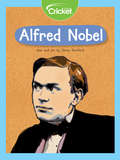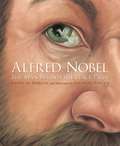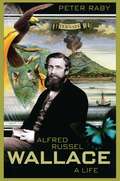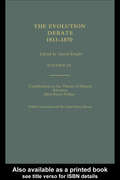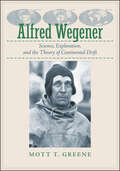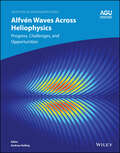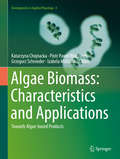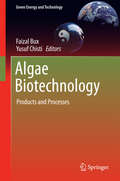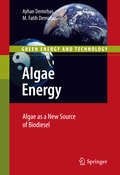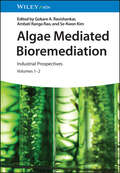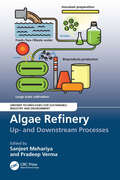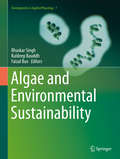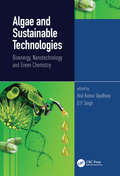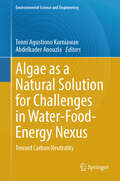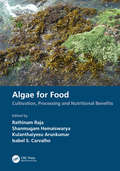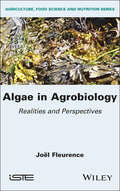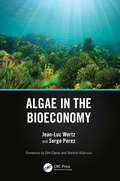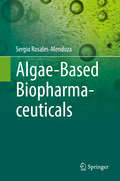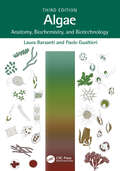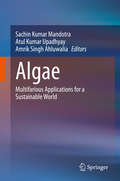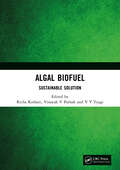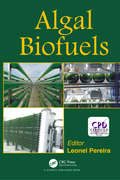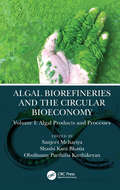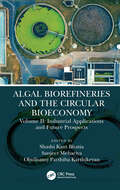- Table View
- List View
Alfred Nobel
by James RumfordDid you know the Nobel Prize is named after the man who invented dynamite? Learn all about the life of Alfred Nobel, who grew up in a desperately poor family.
Alfred Nobel: The Man Behind the Peace Prize
by Kathy-Jo WarginAlfred Nobel was the man who founded what became known as The Nobel Prizes. Nobel also invented dynamite, becoming very wealthy from his invention. Saddened by its use for harmful destruction, Nobel left his fortune to create yearly prizes for those who have rendered the greatest services to mankind.
Alfred Russel Wallace: A Life
by Peter RabyIn 1858, Alfred Russel Wallace, aged thirty-five, weak with malaria, isolated in the Spice Islands, wrote to Charles Darwin: he had, he said excitedly, worked out a theory of natural selection. Darwin was aghast--his work of decades was about to be scooped. Within two weeks, his outline and Wallace's paper were presented jointly in London. A year later, with Wallace still on the opposite side of the globe, Darwin published On the Origin of Species. This new biography of Wallace traces the development of one of the most remarkable scientific travelers, naturalists, and thinkers of the nineteenth century. With vigor and sensitivity, Peter Raby reveals his subject as a courageous, unconventional explorer and a man of exceptional humanity. He draws more extensively on Wallace's correspondence than has any previous biographer and offers a revealing yet balanced account of the relationship between Wallace and Darwin. Wallace lacked Darwin's advantages. A largely self-educated native of Wales, he spent four years in the Amazon in his mid-twenties collecting specimens for museums and wealthy patrons, only to lose his finds in a shipboard fire in the mid-Atlantic. He vowed never to travel again. Yet two years later he was off to the East Indies on a vast eight-year trek; here he discovered countless species and identified the point of divide between Asian and Australian fauna, 'Wallace's Line.' After his return, he plunged into numerous controversies and published regularly until his death at the age of ninety, in 1913. He penned a classic volume on his travels, founded the discipline of biogeography, promoted natural selection, and produced a distinctive account of mind and consciousness in man. Sensitive and self-effacing, he was an ardent socialist--and spiritualist. Wallace is one of the neglected giants of the history of science and ideas. This stirring biography--the first for many years--puts him back at center stage, where he belongs.
Alfred Russell Wallace Contributions to the theory of Natural Selection, 1870, and Charles Darwin and Alfred Wallace , 'On the Tendency of Species to form Varieties' (The\evolution Debate, 1813-1870 Ser.)
by Charles Darwin Alfred Russel Wallace David KnightWallace noticed on expeditions to the Amazon and the Malay archipelego that mammals in Southeast Asia are more advanced than their Australian cousins. His suggestion was that the two continents had split before the better adapted mammals had evolved in Asia. The isolated Australian marsupials were able to thrive, whilst those in Asia were driven to extinction by competition from more advanced mammals. This led to his theory of natural selection, which he presented to the Linnean Society in 1858 with Charles Darwin. This volume reprints those papers presented to the Linnean Society.
Alfred Wegener: Science, Exploration, and the Theory of Continental Drift
by Mott T. GreeneA masterful biography of Alfred Wegener (1880–1930), the German scientist who discovered continental drift.Winner of the CHOICE Outstanding Academic Title of the Choice ACRLAlfred Wegener aimed to create a revolution in science which would rank with those of Nicolaus Copernicus and Charles Darwin. After completing his doctoral studies in astronomy at the University of Berlin, Wegener found himself drawn not to observatory science but to rugged fieldwork, which allowed him to cross into a variety of disciplines. The author of the theory of continental drift—the direct ancestor of the modern theory of plate tectonics and one of the key scientific concepts of the past century—Wegener also made major contributions to geology, geophysics, astronomy, geodesy, atmospheric physics, meteorology, and glaciology. Remarkably, he completed this pathbreaking work while grappling variously with financial difficulty, war, economic depression, scientific isolation, illness, and injury. He ultimately died of overexertion on a journey to probe the Greenland icecap and calculate its rate of drift. This landmark biography—the only complete account of the scientist’s fascinating life and work—is the culmination of more than twenty years of intensive research. In Alfred Wegener, Mott T. Greene places Wegener’s upbringing and theoretical advances in earth science in the context of his brilliantly eclectic career, bringing Wegener to life by analyzing his published scientific work, delving into all of his surviving letters and journals, and tracing both his passionate commitment to science and his thrilling experiences as a polar explorer, a military officer during World War I, and a world-record–setting balloonist. In the course of writing this book, Greene traveled to every place that Alfred Wegener lived and worked—to Berlin, rural Brandenburg, Marburg, Hamburg, and Heidelberg in Germany; to Innsbruck and Graz in Austria; and onto the Greenland icecap. He also pored over archives in Copenhagen, Munich, Marburg, Graz, and Bremerhaven, where the majority of Wegener’s surviving papers are found. Written with great immediacy and descriptive power, Alfred Wegener is a powerful portrait of the scientist who pioneered the modern concept of unified Earth science. The book should be of interest not only to earth scientists, students of polar travel and exploration, and historians but to all readers who are fascinated by the great minds of science.
Alfvén Waves Across Heliophysics: Progress, Challenges, and Opportunities (Geophysical Monograph Series)
by Andreas KeilingAlfvén Waves Across Heliophysics Progress, Challenges, and Opportunities Alfvén waves are fundamental to the dynamics of space plasmas. Recent advances in our knowledge about Alfvén waves have come from several directions, including new space missions to unexplored heliospheric regions, sophisticated rocket campaigns in the auroral zone, enlarged magnetometer arrays and radar networks, and significant advances in computer modeling. Alfvén Waves Across Heliophysics: Progress, Challenges, and Opportunities is an interdisciplinary collaboration from different space science communities to review recent and current Alfvén wave research. Volume highlights include: Alfvén waves in the solar atmosphereAlfvén waves at the giant planetsAlfvén waves at MarsAlfvén waves in moon-magnetosphere systemsAlfvén waves in geospaceAlfvén waves in the laboratory The American Geophysical Union promotes discovery in Earth and space science for the benefit of humanity. Its publications disseminate scientific knowledge and provide resources for researchers, students, and professionals.
Algae Biomass: Towards Algae-based Products (Developments in Applied Phycology #8)
by Katarzyna Chojnacka Piotr Pawel Wieczorek Grzegorz Schroeder Izabela MichalakThis book is a compendium of knowledge on the useful properties of algae in the context of application as a useful component of innovative natural products. It presents all aspects of industrial applications of macroalgae biomass derived from the natural environment. Despite many interesting characteristics, algae are still regarded as undervalued raw material, therefore, present in the following chapters are not only environmental benefits arising from the development of excessive algal biomass, but also the distribution and biology of algae in natural conditions in reservoirs, methods of obtaining extracts from biomass of algae for industrial purposes. Furthermore, it also includes topics such as the use of biomass and algae extracts for the industrial purposes, in animal breeding and for agricultural purposes, as well as the economic aspects of algae biomass harvesting for industrial purposes. The book is intended for a wide audience interested in new methods of obtaining the biomass from the natural environment for industrial purposes and the manufacture of products based on bioactive substances obtained from the environment.
Algae Biotechnology: Products and Processes (Green Energy and Technology)
by Faizal Bux Yusuf ChistiThis book examines the utilization of algae for the development of useful products and processes with the emphasis towards green technologies and processes, and the requirements to make these viable. Serving as a complete reference guide to the production of biofuels and other value added products from micro and macro algae, it covers various aspects of algal biotechnology from the basics to large scale cultivation, harvesting and processing for a variety of products. It is authored and edited by respected world experts in the field of algal biotechnology and provides the most up to date and cutting edge information on developments in the field. Over the past decade there has been substantial focus and related literature on the application of algal biomass for the generation of novel processes and products. 'Algae Biotechnology: Products and Processes' encompasses a holistic approach to critically evaluating developments in the field of algal biotechnology whilst taking into account recent advances and building on the body of knowledge. Aspects of the effects of harmful algae are also discussed, as well as the potential commercial application of algal biotechnology, the techno-economic feasibility of algal biodiesel production and the use of genetic and metabolic engineering for the improvement of yield. Other bioenergy sources such as alcohol fuels, aviation fuels, biohydrogen and biogas are also covered. This book is intended for postgraduates and researchers working in the biofuels and algal industry; it constitutes ideal reference material for both early stage and established researchers.
Algae Energy: Algae as a New Source of Biodiesel (Green Energy and Technology)
by Muhammet Fatih Demirbas Ayhan DemirbasAlgae Energy covers the production of algae culture and the usage of algal biomass conversion products. It also reviews modern biomass-based transportation fuels, including biodiesel, bio-oil, biomethane and biohydrogen. Each chapter opens with fundamental explanations suitable for those with a general interest in algae energy and goes on to provide in-depth scientific details for more expert readers. Algae energy is discussed within the wider context of green energy, with chapters covering topics such as: green energy facilities, algae technology, energy from algae and biodiesel from algae. Algae Energy addresses the needs of energy researchers, chemical engineers, fuel and environmental engineers, postgraduate and advanced undergraduate students, and others interested in a practical tool for pursuing their interest in bio-energy.
Algae Mediated Bioremediation: Industrial Prospectives, Volumes 1 - 2
by Se-Kwon Kim Gokare A. Ravishankar Ambati Ranga Rao, Se-Kwon KimAlgae Mediated Bioremediation Develop new methods for remediating pollution with this cutting-edge guide In a world where environmental remediation and pollution removal are becoming more critical with every passing day, the search for organic and sustainable solutions has never been more critical. Removing organic pollutants through the use of algae has become an especially promising avenue for bioremediation, with a far lower environmental impact than comparable mechanical, physical, or chemical approaches. The possibility of deriving bioenergy from the resulting biomass makes this approach even more potentially critical to a sustainable future. Algae Mediated Bioremediation offers a cutting-edge overview of these processes and their applications. Its comprehensive approach to the problems of pollution abatement and the value of algae as environmental and biotechnological agents include both practical solutions and key gaps in existing research. Algae Mediated Bioremediation readers will also find: Case studies of successful use drawn from across the globe Detailed discussion of remediating aquatic, atmospheric, and terrestrial habitats Applications for value-added products incorporating biomass Algae Mediated Bioremediation is ideal for biotechnologists, biochemists, natural products chemists, and other researchers working in industry or environmental research.
Algae Refinery: Up- and Downstream Processes (Greener Technologies For Sustainable Industry And Environment)
by Pradeep Verma Sanjeet MehariyaAlgae Refinery: Up- and Downstream Processes offers complete coverage of algae refinery, including up- and downstream processes while proposing an integrated algal refinery for the advancement of existing technologies and summarizing the strategies and future perspectives of algal refinery. It provides a concise introduction to the algal science, biology, technology, and application of algae. It explains downstream and upstream steps of algal refinery for the production of algal biomass, with several social benefits. Features: Provides various aspects of algal bioprocess including upstream and downstream processes Explains the major research streams of algae structures and their pathways Covers algal-based CO2 capture technology Explores the potential applications of algae for socioeconomical benefits Deliberates algal bioremediation approach for clean and sustainable development
Algae and Environmental Sustainability (Developments in Applied Phycology #7)
by Faizal Bux Bhaskar Singh Kuldeep BauddhThis book presents the dynamic role of algae in a sustainable environment. Two major aspects, namely bioenergy and bioremediation, have been elaborated in various chapter contributed by scientists and teachers from different geographical areas throughout the world. Algal biofuels is an emerging area of equal interest to researchers, industries, and policy makers working or focusing on alternative (i. e. renewable) fuels. Algae have been an area of interest due to their wide range of applications. Over the last 5 decades, eukaryotic algae have been used in the aquaculture industry as feed for invertebrates, providing a rich source of antioxidants, dietary fiber, minerals and protein. More recently, there has been a focus on the use of algal biomass in the development of alternative fuels. The extraction of oil from algae has been widely explored as a much more viable feedstock than plant-based oils in large-scale fuel production. using algae as feedstock has the advantages that it doesn't require arable land and that wastewater can be used as a source of nutrients in their culture. The multifunctional approach of algae includes pollution remediation, carbon sequestration, biofuels production, and delivery of value-added products. However, there are still some obstacles that need to be overcome to make their use as potential feedstock for biofuels techno-economically feasible. In order to maintain the sustainability aspect of algal biofuels, various aspects have to be studied and critically analyzed to assess the long-term sustainability of algal derived biofuels. This book discusses the role of algae as a promising future feedstock for biofuels. They are known to sequester carbon in much larger amounts than plants and as such the book also describes their phycoremediation potential for conventional as well as emerging contaminants. It describes the role of anaerobic digestion in algal biorefineries; bioreactions and process parameters; biogas recovery and reuse. The role of algal biofilm based technology in wastewater treatment and transforming waste into bio-products is discussed, and remediation of sewage water through algae is assessed. The book also describes the production of biohydrogen, bio-oil, biodiesel; and the major bottlenecks in their usage. The emerging characterization techniques of these biofuels (bio-oil and biodiesel) are described, as are the decolorizing potential of algae and the genetic engineering techniques that could enhance the production of lipids in algae. Other aspects of the book include the role of remote sensing technology in the monitoring of algae and a life cycle assessment of algal biofuels.
Algae and Sustainable Technologies: Bioenergy, Nanotechnology and Green Chemistry
by Atul Kumar Upadhyay D. P. SinghAlgal and sustainable technologies: Bioenergy, Nannotechnology and Green chemistry is an interdisciplinary overview of the world’s major problems; water scarcity, clean environment and energy and their sustenance remedy measures using microalgae. It comprehensively presents the way to tackle the socio-economic issues including food, feed, fuel, medicine and health and also entails the untapped potential of microalgae in environmental management, bioenergy solution and sustainable synthesis of pharmaceutical and nutraceutical products. This book basically emphasizes the success of algae as wonderful feed stocks of future and provides upto date information and sustainable and recreational outlook towards degrading environment and energy crisis. Applicability of fast emerging algae based nanotechnology in bioremediation and production of nanoparticle (AuNP, AgNP etc) are beautifully described along with latest research and findings. Key features: The "waste to best to income" strategies are the main concern of the book and take the edge off the problem of pollution, energy and income. Elucidate the sustainable phycoremediation and nanoparticle functions as low cost approach for various ecosystem services. Information regarding pharmaceuticals, nutraceuticals and other algae based value added product synthesis and fate are comprehensively discussed. Knowledge resource, latest research, findings and prospects presented in an accessible manner for researchers, students, eminent scientists, entrepreneurs, professionals and policy maker.
Algae as a Natural Solution for Challenges in Water-Food-Energy Nexus: Toward Carbon Neutrality (Environmental Science and Engineering)
by Abdelkader Anouzla Tonni Agustiono KurniawanThis book provides an overview of challenges and opportunities for algal management to mitigate climate change. This book offers new perspectives on how to control water pollution due to algae, while converting it to biosorbent and biodiesel that could be sold in market. The work also explores how to improve the performance of algae for such purposes. By identifying existing knowledge gap, this work uncovers new research directions for further development of algal management to address global environmental pollution. • Extensive literature survey (2001-2023) in algal management based on empirical approach in the body of knowledge • A comprehensive overview with critical analysis of algal management, for water treatment, biodiesel production, and food production, while dealing with climate change • Providing insights about challenges, research direction, outlook, and perspectives of algal management in Industry 4.0 era This book has an advantage that each chapter will be written by experts around the world working in their respective fields. As a result, this volume presents a balanced picture across the whole spectrum of algae. Furthermore, the authors are from both the developing and developed countries thus giving a worldwide perspective of looming climatic problems.
Algae for Biofuels and Energy (Developments in Applied Phycology #5)
by Navid R. Moheimani Michael A. BorowitzkaMicroalgae are one of the most studied potential sources of biofuels and bioenergy. This book covers the key steps in the production of renewable biofuels from microalgae - strain selection, culture systems, inorganic carbon utilisation, lipid metabolism and quality, hydrogen production, genetic engineering, biomass harvesting, extraction. Greenhouse gas and techno-economic modelling are reviewed as is the 100 year history of microalgae as sources of biofuels and of commercial-scale microalgae culture. A summary of relevant basic standard methods used in the study of microalgae culture is provided. The book is intended for the expert and those starting work in the field.
Algae for Food: Cultivation, Processing and Nutritional Benefits
by Shanmugam Hemaiswarya Rathinam Raja Kulanthaiyesu Arunkumar Isabel S. CarvalhoAlgae for Food: Cultivation, Processing and Nutritional Benefits Algae are a primitive, living photosynthetic form and they are the oldest living organism. In the marine ecosystem, algae are the primary producers that supply energy required to a diverse marine organism and especially seaweed provides a habitat for invertebrates and fishes. There have been significant advances in many areas of phycology. This book describes the advances related to food and nutrition of algae achieved during the last decades, it also identifies gaps in the present knowledge and needs for the future. The 17 chapters, grouped into 6 parts, are written by phycologists. More insight on industrial exploitation of algae and their products is supported by current studies and will help academia. The first part explains new technologies to improve the microalgal biomass, strain improvement and different methods of seaweed cultivation. In the second part, food and nutraceutical applications of algae, food safety aspects, green nanotechnology and formulation methods for the extraction and isolation of algal functional foods are described. The third part deals with pigments and carotenoids while the fourth part exploits the isolation and application of hydrocolloids, nutritional implications of algal polysaccharides and the characterization and bioactivity of fucoidans. In the fifth part, the biomedical potential of seaweed followed by agricultural applications of algae are well described. The book is an important resource for scholars that provides knowledge on wide range of topics. Key Features Covers important fields of algae from biomass production to genetic engineering aspects of algae Useful in the field of algal biotechnology, aquaculture, marine micro and macrobiology, microbial biotechnology and bioprocess technology Focuses on the therapeutic and nutritional areas of algae
Algae in Agrobiology: Realities and Perspectives
by Joel FleurenceAlgae, macroalgae and microalgae can be valuable biological resources in a new, more environmentally friendly form of agriculture known as agrobiology. Indeed, the biological properties associated with algae are frequently relevant for agricultural and zootechnical purposes. It is this aspect that is behind the current popularity of algae in the development of new agricultural practices that are related to plant and animal production, which are referred to as agrobiology. Algae in Agrobiology offers a current and forward-looking account of algae use: in agriculture and in the sector of land and marine animal production, as algal extracts and molecules in the form of fertilizers or biostimulants for crops with agronomic interest, and as algal compounds in the area of plant and animal health. This book is based on advances in biochemical and agronomic research in order to explain the conventional practices associated with the use of algae in agriculture and livestock breeding. These advances make it possible to establish possible uses for marine algal resources in the agriculture of the future.
Algae in the Bioeconomy
by Jean-Luc Wertz Serge PerezAlgae play an important ecological role as oxygen producers and carbon sequesters and are the food base for all aquatic life. Algae are economically important as a source of crude oil, food and feed, and pharmaceutical and industrial products. High-value and sustainable products from algae are already economically viable and can be a fundamental driver for fuel production. Algae in the Bioeconomy provides a detailed overview of the chemical composition of algae and shows that an integrated biorefinery approach is necessary for large-scale algae production and conversion, where multiple products are produced. This book serves as a unique compendium of knowledge covering the essential features of algae and their applications. Discusses the structural chemistry and biology of micro- and macroalgal components Describes classification, occurrence, conversion, and production of micro- and macroalgae Offers strategies for optimal use of micro- and macroalgae in the bioeconomy, including regional strategies in the EU, US, China, India, Malaysia, Norway, and Chile Features forewords from international experts offering both a scientific and an economic/strategic viewpoint This book is intended for an interdisciplinary audience in chemical engineering, biotechnology, and environmental science and engineering, promoting research, development, and application of algae as a sustainable resource.
Algae-Based Biopharmaceuticals
by Sergio Rosales-MendozaThis book constitutes a key reference on the use of algae in the BFs production field; providing an updated outlook on the achievements accomplished thus far and transmitting a prospective view for this biotechnological application. This book provides a detailed description of the technology as well as an updated outlook of the strides achieved thus far in the field of algae-based biopharmaceuticals. Algae constitute attractive expression hosts for the production of recombinant proteins with medical applications. Among the features make them attractive candidates are: low cost, fast growth, wide biosynthetic capacity, and absence of human pathogens; which constitute substantial advantages with respect to bacterial and mammalian systems. First, the features of algae as convenient hosts for the production of BFs are analyzed in terms of production costs, biosynthetic capacity, and safety (Chapter 1). Second, the genetic engineering tools for algae-species are described. Nuclear and chloroplast-based expression approaches are analyzed and compared in terms of biosynthetic advantages, gene expression complexity, and DNA transfer approaches (Chapter 2). In the following sections, chapters 3 to 7, the state of the art on producing distinct types of BFs in algae species is presented. Although this book is mainly focused on BFs, considering that the production of compounds with health-promoting properties are achieved using genetically-engineered algae strains, chapter 8 deals with nutraceuticals. In the ninth chapter, the developments reported thus far are placed in perspective and challenges for the field are discussed. Critical future prospects comprise the following: optimizing large-scale production in bioreactors, implementing glycoengineering approaches, optimizing nuclear expression, exploring new approaches for oral delivery, and implementing regulatory frameworks to accomplish technology transfer and regulatory approval of algae-made BFs.
Algae: Anatomy, Biochemistry, and Biotechnology
by Laura Barsanti Paolo GualtieriA single-source reference on the biology of algae, the third edition of Algae: Anatomy, Biochemistry, and Biotechnology examines the most important taxa and structures for freshwater, marine, and terrestrial forms of algae. Its comprehensive coverage goes from algae's historical role through its taxonomy and ecology to its natural product possibilities. In this update, the authors have gathered a significant amount of new material, including: • more information on macroalgae • detailed description of biotic associations • updated description of biomass cultivation systems • coverage of different "omic" approaches and tools used in algal investigation • an expanded and updated algae utilization chapter The book's unifying theme is the important role of algae in the earth's self-regulating life support system and its function within restorative models of planetary health. It also discusses algae's biotechnological applications, including potential nutritional and pharmaceutical products. Written for students as well as researchers, teachers, and professionals in the field of phycology and applied phycology, this new full-color edition is both illuminating and inspiring.
Algae: Multifarious Applications for a Sustainable World
by Atul Kumar Upadhyay Sachin Kumar Mandotra Amrik Singh AhluwaliaThis exciting book presents diverse applications of microalgal renewable resources to meet modern demands for energy and value-added products. It also comprehensively describes the role of algae in sustainable and cost-effective wastewater treatment strategies, and highlights the latest research on, advances in and biotechnological relevance of algae in the areas of bioenergy, bioremediation, pharmaceuticals, nutraceuticals and green economy. The book addresses gaps in the fields of bioenergy, waste management, health and economy by providing broad information on bioenergy production, management strategies, drug development, nutraceuticals products and biobased economy using algae at the commercial level. The book introduces researchers to key and emerging innovations in the field of algal biology research and will assist policymakers, environmentalists, scientists, students and global thinkers in defining sustainable developmental goals for the future. Accordingly, it is an extremely important read for researchers and students in the environmental sciences, life sciences and chemistry, experts in the energy sector and policymakers alike.
Algal Biofuel: Sustainable Solution
by Richa Kothari V. V. Tyagi Vinayak V. PathakAlgal Biofuel: Sustainable Solution primarily focuses on the different aspects of bioenergy production using algal biomass as microalgae are considered the optimum feedstock for bioenergy production. The major aim is to thoroughly review the available bioenergy options, challenges in bioenergy production, availability of bioenergy feedstock, and biomass to bioenergy conversion process. This book also highlights the feasibility of lignocellulosic biomass, crop residues, and non-edible oil seeds for generation of different bioenergy products. It will be helpful for researchers and other stakeholders working in the area of bioenergy production for development of innovative concepts in emerging areas of bioenergy. Print edition not for sale in South Asia (India, Sri Lanka, Nepal, Bangladesh, Pakistan and Bhutan).
Algal Biofuels
by Leonel PereiraAlgae presents a viable biofuel alternative because the production of algae for fuel, unlike other agro-based biofuels, does not compete with food production. This book covers algae-based biofuel options and discusses the design and economic viability of algal bioenergy co-production concepts.
Algal Biorefineries and the Circular Bioeconomy: Algal Products and Processes
by Sanjeet Mehariya"Algae are mysterious and fascinating organisms that hold great potential for discovery and biotechnology." —Dr. Thierry Tonon, Department of Biology, University of York "Science is a beautiful gift to humanity; we should not distort it." —A.P.J. Abdul Kalam In this book, we emphasize the importance of algal biotechnology as a sustainable platform to replace the conventional fossil-based economy. With this focus, Volume 2 summarizes the up-to-date literature and knowledge and discusses the advances in algal cultivation, genetic improvement, wastewater treatment, resource recovery, commercial operation, and technoeconomic analysis of algal biotechnology. FEATURES Discusses in detail recent developments in algae cultivation and biomass harvesting Provides an overview of genetic engineering and algal-bacteria consortia to improve productivity Presents applications of algae in the area of wastewater treatment and resource recovery Provides case studies and technoeconomic analysis to understand the algal biorefinery Shashi Kant Bhatia, PhD, is an Associate Professor in the Department of Biological Engineering, Konkuk University, Seoul, South Korea. Sanjeet Mehariya, PhD, is a Postdoctoral Researcher at the Department of Chemistry, Umeå University, Umeå, Sweden. Obulisamy Parthiba Karthikeyan, PhD, is a Research Scientist and Lecturer (Adjunct) in the Department of Civil and Environmental Engineering, South Dakota School of Mines and Technology, Rapid City, South Dakota, USA.
Algal Biorefineries and the Circular Bioeconomy: Industrial Applications and Future Prospects
by Shashi Kant Bhatia"Algae are mysterious and fascinating organisms that hold great potential for discovery and biotechnology." —Dr. Thierry Tonon, Department of Biology, University of York "Science is a beautiful gift to humanity; we should not distort it." —A.P.J. Abdul Kalam In this book, we emphasise the importance of algal biotechnology as a sustainable platform to replace the conventional fossil-based economy. With this focus, Volume 2 summarizes up-to-date literature knowledge and discusses the advances in algal cultivation, genetic improvement, wastewater treatment, resource recovery, commercial operation, and technoeconomic analysis of algal biotechnology. FEATURES Discusses in detail recent developments in algae cultivation and biomass harvesting Provides an overview of genetic engineering and algal-bacteria consortia to improve productivity Presents applications of algae in the area of wastewater treatment and resource recovery Provides case studies and technoeconomic analysis to understand the algal biorefinery Shashi Kant Bhatia, PhD, is an Associate Professor in the Department of Biological Engineering, Konkuk University, Seoul, South Korea. Sanjeet Mehariya, PhD, is a Postdoctoral Researcher in the Department of Chemistry, Umeå University, Umeå, Sweden. Obulisamy Parthiba Karthikeyan, PhD, is a Research Scientist and Lecturer (Adjunct) in the Department of Civil and Environmental Engineering, South Dakota School of Mines and Technology, Rapid City, South Dakota, USA.
